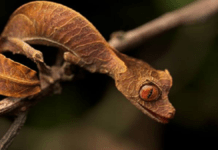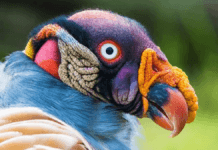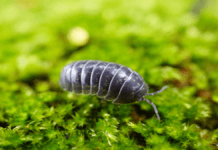Of all the birds in the world, hummingbirds are the smallest ones. There are about 357 different hummingbird species. They are absolutely a dazzling sight. But most of the time many of us could only see full-grown adult hummingbirds. As these birds are so small, we can easily miss them during their early life stages. But the development of baby hummingbirds is a wonderful incident in nature that everyone must know. That’s why I decided to bring you some amazing facts about those baby hummingbirds. Before talking about the baby hummingbirds, let’s start from the beginning!

#1 How do hummingbirds build their nests?
Before mating, female hummingbirds start to build their nests. The building process usually takes less than a week. They normally use spider webs as a basement to attach their nest to a branch, a rock crevice, or a leaf. Once it is completed, the interior is decorated with soft plant materials and the exterior is decorated with lichens, which helps to camouflage the nest.
#2 How do hummingbird eggs look like?

Their birds are normally white and elliptical. They are very tiny and usually like small jelly beans in size. Most hummingbird eggs weigh no more than a gram. After an adult pair mates, usually it takes around 24 to 30 hours to develop eggs within the female’s body. Hummingbird females usually lay two eggs at a time. There’s a space of one or two days between laying those eggs.
#3 In which period do hummingbirds breed?
The breeding period of the hummingbirds depends on where they live. For example, most North American hummingbirds breed in late spring after they reach their breeding grounds. Hummingbirds have a long breeding season in warm climates. Anna’s Hummingbird is a species that inhabits Southern Canada and the West Coast of the United States. It starts nesting in California in November and its breeding season stops in June.
#4 What does a baby hummingbird looks like?

Usually, most people use the word “baby” to describe little ones. It is same for the world’s smallest bird. But ornithologists use some different words to describe newly hatched birds. Chick, nestling, or hatchling are those names. The name of young hummingbirds depends on their age. As mentioned before, newly hatched ones are known as chicks, nestlings, or hatchlings. When they are mature enough to leave their nests, they are called fledglings. When hummingbirds are hatched, they have no feathers and hatch with their eyes closed. Those chicks are incredibly small and have pink or gray colored skin. As their feet are so tiny, they cannot stand. During the first few weeks, hummingbird chicks are completely helpless. They have to depend on their mothers for warmth and food. Young ones get a full set of feathers when they are around three weeks old.
#5 How long does it take a baby hummingbird to fly?
After hatching, hummingbird babies take less than a month to start flying. When they are around two weeks old, they start to do exercises to their wings and prepare for their first flight. They come to the edge of the nest and start to stretch their wings. When they are ready, they leave the nest. This is called fledging. When they are one month old, they become independent and are ready to start their first journey.
#6 What do baby hummingbirds eat?

For fast growth and to develop strong beaks and bones, hummingbird chicks need a diet of insects with high protein. Not only that, but to meet their high-energy needs, they also need nectar. So hummingbird mothers find food several times per day and feed babies by regurgitating food items into their mouths. Those mothers continuously feed their chicks until they are one month old. But in some tropical species, it becomes long as 45 to 60 days.
#7 Baby Hummingbirds don’t poop in their nests!
Actually, hummingbird chicks are very small and defenseless. And seems like they are unable to do anything independently. But they have an interesting instinct when considering their urge to poop. Baby hummingbirds know not to poop in their nests from birth. Even though they cannot fly, they have an interesting behavior to avoid pooping inside the nest. When they have the urge, they arch backs and stick their tails in the air. Then they poop from the side of the nest.
They can release both pee and poop from the same opening at the same time. According to researchers, this ability helps them to be safe from predators. Simply the less time they spend still, the safer they are.
#8 The smallest Hummingbird chick in the world is the Bee Hummingbird!

The bee hummingbirds can be exclusively seen in Cuba. Because of their small size, sometimes they are mistaken for actual bees. And also this species is the one that creates the smallest nest. Usually the size of a bee hummingbird egg is about a coffee bean. When the bee hummingbird chicks are born, their size is roughly the same as a large raisin. Bodies of the newborn bee hummingbirds are black and wrinkly. From 7 to 10 days after birth, feathers are grown in their bodies and they also double their weights after about two days of their birth.
#9 Hummingbird nests can stretch
Even though baby hummingbirds are very tiny at birth, it only takes about a month to become adults. As mothers create little nests for the babies, they would need to change the nests when babies are growing. But luckily they have a solution to this problem. Their nests can stretch when the chicks grow! Female hummingbirds use feathers and twigs to build their nest. But in addition to those, they use cotton fibers and spider silk which allows hummingbird nests to stretch as chicks get older.
#10 All Hummingbird eggs at the nest hatch on the same day

Usually, a female hummingbird lays 1 to 3 eggs. Female hummingbirds need lots of energy to lay eggs. And also hummingbirds only consume food only enough to sustain their energy for one night. So normally there is a one or two-day gap between laying eggs. But the interesting thing is, even if those eggs are laid on different days, all of them hatch on the same day. You may think it is impossible. But that’s true! Would you like to know the reason?
Well, the answer is simple. Female hummingbirds do not start to incubate their eggs until they lay all the eggs. This ensures that all eggs get the same incubation time and they go through the same development stage. Then finally all those eggs hatch on the same day.

















